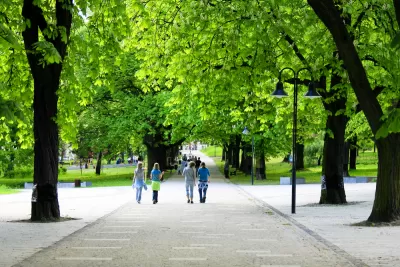As temperatures rise, there are some relatively simple changes cities can implement to cut cooling costs and deal with spells of extreme heat.

According to one study, the number of days in a year across the United States that feel hotter than 100 degrees Fahrenheit will more than double by mid-century. That's bad news for cities designed in ways that often exacerbate urban heat, Adele Peters writes. While broad infrastructural changes (and, ultimately, the elimination of fossil fuels) will do the most to combat an even hotter future, simple mitigation methods do exist for the heat that cities are already feeling.
When it comes to planting urban trees, "There are multiple benefits, but one is simple: As trees shade streets, and water evaporates from their leaves, they cool neighborhoods." Cities like Melbourne, Milan, and Madrid are all engaged in ambitious plans to grow out their urban forests.
Other cities, like New York, Los Angeles, and Tokyo, are covering rooftops and pavements with reflective coating. "The coating helps lower temperatures inside buildings, helping people feel more comfortable and use less air conditioning; like cars, air conditioners are both another major source of emissions and make cities immediately hotter as the machines vent heat outside."
Another way to fight urban heat is to equip structures with "smart" systems like automatic shades and windows programmed to respond to heat conditions, and to choose building materials with heat mitigation in mind. In the end, Peters notes, reducing automobile dependence will also play a role. "Cities that incentivize less driving—whether by redesigning bike lanes and sidewalks or changing codes to make new developments mixed-use and near public transportation—can cool themselves down."
FULL STORY: Cities are getting hotter, but we can redesign them to keep us cool

Planetizen Federal Action Tracker
A weekly monitor of how Trump’s orders and actions are impacting planners and planning in America.

San Francisco's School District Spent $105M To Build Affordable Housing for Teachers — And That's Just the Beginning
SFUSD joins a growing list of school districts using their land holdings to address housing affordability challenges faced by their own employees.

The Tiny, Adorable $7,000 Car Turning Japan Onto EVs
The single seat Mibot charges from a regular plug as quickly as an iPad, and is about half the price of an average EV.

With Protected Lanes, 460% More People Commute by Bike
For those needing more ammo, more data proving what we already knew is here.

In More Metros Than You’d Think, Suburbs are Now More Expensive Than the City
If you're moving to the burbs to save on square footage, data shows you should think again.

The States Losing Rural Delivery Rooms at an Alarming Pace
In some states, as few as 9% of rural hospitals still deliver babies. As a result, rising pre-term births, no adequate pre-term care and "harrowing" close calls are a growing reality.
Urban Design for Planners 1: Software Tools
This six-course series explores essential urban design concepts using open source software and equips planners with the tools they need to participate fully in the urban design process.
Planning for Universal Design
Learn the tools for implementing Universal Design in planning regulations.
Smith Gee Studio
City of Charlotte
City of Camden Redevelopment Agency
City of Astoria
Transportation Research & Education Center (TREC) at Portland State University
US High Speed Rail Association
City of Camden Redevelopment Agency
Municipality of Princeton (NJ)




























